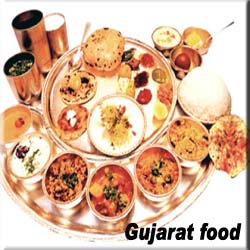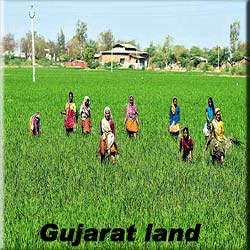CULTURE IS THE ART OF LIVING
The Gujarati's get their lineage from the Gurjars who came to India along with the Huns and when they were travelling and had to cross through Punjab they got settled in Gujarat. The Gujarati's are mainly Indo Aryan origin and of which at least 20% constitute the tribal group like Bhils, Kolis, Dhubla, Naikda and Macchi-Kharwa who still exist in the state. Though the state was invaded by the Aryans who came from the north, they were not able to either conquer or send away the tribes of the Bhil community who soon became the traditional rulers of Gujarat. The Koli community of Kurjars also occupies standard position between the Aryans and the Bhils.
The culture of Gujarat can be best expressed as comprising the following :
ORIGIN
Gujarat soon became a multi-religious culture for the fact that during the medieval period there was lot of immigration into the state which brought Islam and Zoroastrianism with lot of followers for it. Predominant of the Guajarati who settled down in Saurashtra during the fourteenth century were known as Kathis and they were the worshippers of the Sun god. The Kathis being nomads were good in the art of horse-breeding. But again due to immigrants into this part of Gujarat led to a multi ethnic culture. Saurashtra was soon dominated by the Rabris who belong to the royal families. The Rabri community was mainly cattle breeders and had their lineage from a Rajput clan. ETHNICITY
The Guajarati's speak the Guajarati language. People of the Gujarati ethnicity are primarily located in the northwestern part of the Indian subcontinent, specifically in Gujarat, Rajasthan, and Maharashtra and Madhya Pradesh regions of India. There are considerable amount of Guajarati's living in other parts of the country like Daman and Diu and Dadra and Nagar Haveli and also in Pakistan. Few of the Guajarati's who migrated to Pakistan especially after the partition in 1947 have got themselves converted to Muslims who mainly come under the following communities Memon, Khoja, and Bohra groups where majority of them got settled in Karachi who still consider their ethnicity to be Gujarat and they are the Guajarati's. CULTURE
The Gujarati's are known for their diverse cultural heritage and rich traditions. It is a vibrant mix of Hinduism, Islam, Jainism and Buddhism and also a blend of different cultures of the Guajarati's like arts, beliefs, customs, traditions, institutions, inventions, language, technology and values. The culture of the people does not stop with one particular generation but instead the elders of the community see to that the future generations also practice it which automatically leads to the wisdom and appreciation of cultural traditions and lifestyles. They also as a part of their culture join hands to greet the guests and the elders. The lifestyle of the people of Gujarat is very balanced because of the fact that they have a perfect system of learning, religious practices and excellent forms of artistic expressions. The culture of the Gujarati's does not only prevails in Gujarat but it has been widespread to different parts of the world and now recognized as an international culture. There is not much of culture shock seen in the people of Gujarat and so it makes people bold and courageous with lot of energy to face different challenges raised by the global scenario. CUSTOMS AND TRADITIONS
Though modern and sophisticated houses have come in Gujarat, still there are places which have their traditional homes and wooden houses. Most of these traditionally built houses have beautiful and intricately designed interiors but as a customary practice each house has a special "Chabutara" built for bird feeding. Pachchikam jewelry is one of the traditional jewelry of the people of Gujarat where instead of gold, the metal used in making of this ornament is silver. The Gujarathi women as a part of their tradition carry a bunch of keys on their waist and the ring holder is usually made of silver. Some other jewelery which is worn by the ladies as part of their customs includes mangalsutra, earrings, necklace, rings and bangles. The Gujarathis have lot of belief in various gods and goddesses. Cow is considered as mother God or "Gau-Mata" and the Gujarathi's have lot of faith in them. Some of the ceremonies which are must to be celebrated by the people of Gujarat are birth, thread ceremony, marriage and death. In all these ceremonies the rituals and poojas are performed by the Brahmans. As a part of the Gujarathi's custom and tradition they celebrate festivals like Navratri and Diwali. COSTUME
Like any other culture of the country, Gujarathis also adorn themselves with mangalsutras, necklaces, nose rings, earrings, bangles and rings, toe rings and bracelets. It is a must among the married women of Gujarat to wear a red bindi which may be either powder or sticker on their forehead. Also married women stretch the red powder, called 'sindoor', in a short straight line on the scalp, starting near the hairline and cover the area where the hair is generally parted. The most common traditional outfit for the Gujarathi ladies especially at times of occasions are saris which are draped in such a way that the pallu comes over the front of their right shoulder and across the chest tucked into the waist.Salwar Kamiz is also in vogue among married and old women.Traditional attire of the males of Gujarat are dhotis and a kurta is worn on top. The traditional outfits of ladies are chania choli and of men it is called as kedia dress. ART AND CRAFTS
The people of Himachal Pradesh are known for their wooden crafts because the region has abundance of trees like Pine, Cedrus deodar, walnut, horse chestnut and wild black mulberry which are used for craft work and carvings of doors, windows, balcony panels, etc.They are also known for metal craft. Antique metal statuettes are one of the most significant aspects in many temples of Himachal Pradesh. The statues of gods and goddesses also appear as mohras or in metal plaques. Household utensils are made using brass which is very famous. They are also involved in making things from bamboo items like boxes, sofas, chairs, baskets and rack. Pashmina shawl and the colourful Himalayan caps are in demand in overseas also. CUISINE

OCCUPATION

FAMOUS PERSONALITIES
Sam Pitroda -Businessman and Father of communication revolution of Modern India.Sam Manekshaw -Military, Chief of Army Staff, and India's first Indian Field Marshal.
Mohandas Karamchand Gandhi -Freedom fighter and Father of Nation of India.
Umashankar Josh - iLiterature


